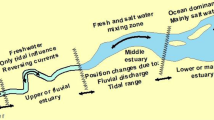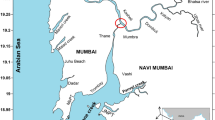Abstract
In previous studies we have ascertained that inflows and seawater intrusion in the Shatt al-Arab River (SAR) are two key physical factors behind fluctuating and sharply escalating salinities observed in recent years. Such levels require a series of countermeasures and investigative studies to translate physical factors into a salinity dynamics model to understand the problem and its impact as these factors vary in location, time and quantity. A one-dimensional hydrodynamic and salt intrusion numerical model was applied to simulate the complex salinity regime in the SAR based on hourly time-series data for the year 2014. The model was used to analyse the impact of different management scenarios on salinity under different conditions. The results show a high correlation between seawater intrusion and river discharge. Increased use of water upstream and local water withdrawals along the SAR will increase seawater intrusion and salinity concentrations. Improving the quantity and quality of the upstream freshwater sources could reduce salinity levels. Discharging the drainage water into the river could be used to counteract the salt intrusion, considering that its location affects both the salinity distribution and extent. A scenario analysis based on a numerical model constructed for the longitudinal salinity variation associated with different sources in a tidal regime, can efficiently screen alternative water management strategies.






Similar content being viewed by others
References
Abdullah A, Karim U, Masih I, Popescu I, van der Zaag P (2016) Anthropogenic and tidal influences on salinity levels and variability of the Shatt al-Arab River, Basra, Iraq. International Journal of River Basin Management 14(3):357–366
Abdullah A, Masih I, Van der Zaag P, Karim U, Popescu I, Al Suhail Q (2015) The Shatt al Arab system under escalating pressure: a preliminary exploration of the issues and options for mitigation. International Journal of River Basin Management 13:215–227
Ajeel S, Abbas M (2012) Diversity of Cladocera of the Shatt al Arab River southern Iraq. Mesopot J Mar Sci 27:126–139
Al-Meshleb N (2012) Systematic and ecological study of recent Ostracoda from al Faw town, south of Iraq. MesopotJ Mar Sci 27(2):88–103
Al-Saad HT, Farid WA, Al-Adhub AY (2011) Uptake and depuration of water-soluble fractions (WSF) of crude oil by the bivalve Carbicula fluminea (Muller) from Shatt al- Arab River. Mesopotamian Journal of Marine Science 26:134–145
Ayers S, Westcot W (1985) Water quality for agriculture, FAO irrigation and drainage paper 29 rev. 1. Food and agriculture Organization of the United Nations, Rome
Becker M, Luettich R, Mallin M (2010) Hydrodynamic behaviour of the cape fear river and estuarine: a synthesis and observational investigation of discharge-salinity intrusion relationships. Estuar Coast Shelf Sci 88:407–418
CUR (1993) Hydrology and water management of deltaic areas. Report 93–5, Ministry of transport, public works and water management, The Netherlands
El-Adawy A, Negm A, Elzeir M, Saavedra O, El-Shinnawy I, Nadaoka K (2013) Modeling the hydrodynamics and salinity of el-Burullus Lake (Nile Delta, northern Egypt). Journal of Clean Energy Technologies 1:157–163
Fernandez-Delgado C, Baldo F, Vilas C, Garcia-Gonzalez D, Cuesta J, Gonzalez-Ortegon E, Drake P (2007) Effects of the river discharge management on the nursery function of the Guadalquivir River estuary (SW Spain). Hydrobiologia 587:125–136
Hameed H, Aljorany Y (2011) Investigation on nutrient behavior along Shatt al-Arab River, Basra, Iraq. J Appl Sci Res 7:1340–1345
Jassby A, Kimmerer W, Monismith S, Armor C, Cloern J, Powell T, Schubel J, Vendlinski T (1995) Isohaline position as a habitat indicator for estuarine populations. Ecol Appl 5:272–289
Kirchner J, Moolman J, Du-Plessis H, Reynders A (1997) Causes and management of salinity in the Breede River valley, South Africa. Hydrogeol J 5:98–108
Lesser G, Roelvink J, Van Kester M, Stelling G (2004) Development and validation of a three-dimensional morphological model. Coast Eng 51:883–915
Maser M, Son M, Yasser A (2011) Assessing the risks of invasions of aquatic invertebrates in the Shatt al-Arab River. Russian Journal of Biological Invasions 2:120–125
Mohammed M (2011) Modified method for the determination of cobalt (II) and copper (II) ions by adopting Schiff base complexes in water of Shatt al Arab River. Mesopotamian Journal of Marine Science 26:170–181
Myakisheva N (1996) The influence of seasonal and year-to year variability of water discharge from the Lake Ladoga-Neva River system on the salinity regime of the Baltic Sea. Hydrobiologia 322:99–102
Nguyen A, Savenije H (2006) Salt intrusion in Multi-Channel estuaries: a case study in the Mekong Delta, Vietnam. Hydrol Earth Syst Sci 10:743–754
Peters N, Meybeck M (2000) Water quality degradation effects on freshwater availability: impact of human activities. International Water Resources Association, Water International 25:185–193
Quinn N (2011) Adaptive implementation of information Technology for Real-Time, basin-scale salinity Management in the san Joaquin Basin, USA and Hunter River basin, Australia. Agric Water Manag 98:930–940
Rahi K, Halihan T (2010) Changes in the salinity of the Euphrates River system in Iraq. Reg Environ Chang 10:27–35
Roos J, Pieterse A (1995) Salinity and dissolved substances in the Vaal River at Balkfontein, South Africa. Hydrobiologia 306:41–51
Shiati K (1991) A regional approach to salinity Management in River Basins, a case study in South Iran. Agric Water Manag 19:27–41
Thomas G, Jakeman A (1985) Management of Salinity in the river Murray Basin. Land Use Policy 2(2):87–101
UNEP (2001) The Mesopotamian marshlands: demise of an ecosystem, early warning and assessment technical report, UNEP/DEWA/TR.01-3 rev. 1 division of early warning and assessment United Nations environment Programme Nairobi, Kenya
Van Breemen M (2008) Salt intrusion in the Selangor estuary in Malaysia. MSc dissertation, University of Twente
Van den Heuvel S (2010) Modeling the hydrodynamics and salinity of the Pontchartrain Basin. MSc dissertation, Delft University of Technology
Van der Zaag P (2007) Asymmetry and equity in water resources management; critical institutional issues for southern Africa. Water Resour Manag 21:1993–2004
WHO (1996) Guidelines for drinking-water quality - second edition - volume 2 - health criteria and other supporting information. World Health Organization, Geneva
Author information
Authors and Affiliations
Corresponding author
Rights and permissions
About this article
Cite this article
Abdullah, A.D., Popescu, I., Dastgheib, A. et al. Analysis of Possible Actions to Manage the Longitudinal Changes of Water Salinity in a Tidal River. Water Resour Manage 31, 2157–2171 (2017). https://doi.org/10.1007/s11269-017-1634-5
Received:
Accepted:
Published:
Issue Date:
DOI: https://doi.org/10.1007/s11269-017-1634-5




